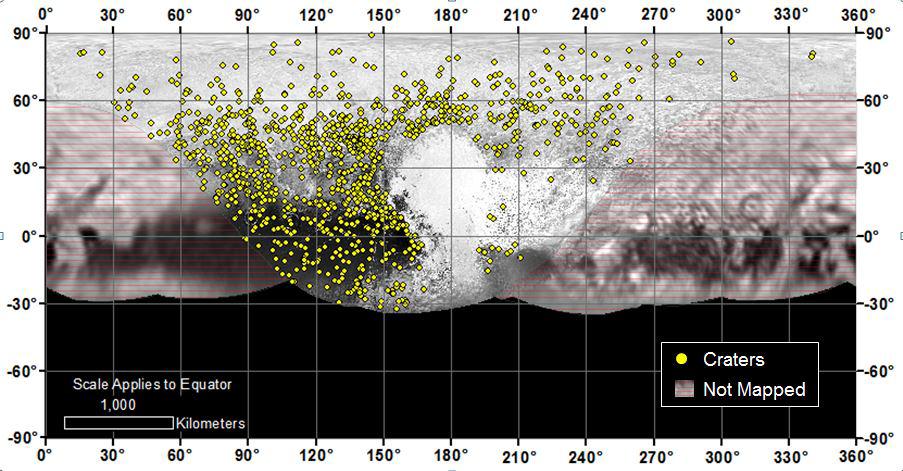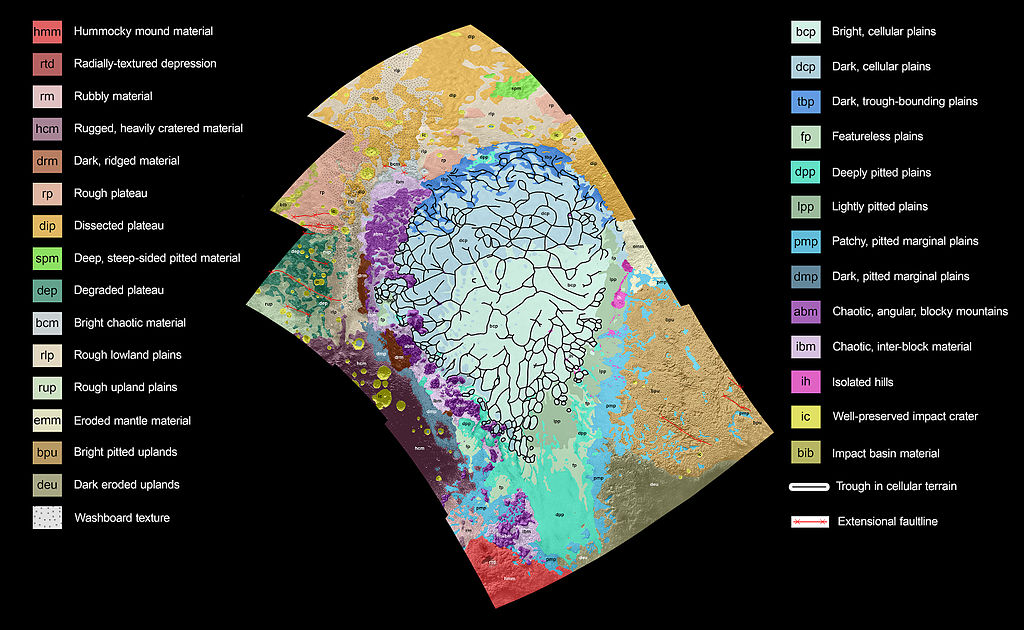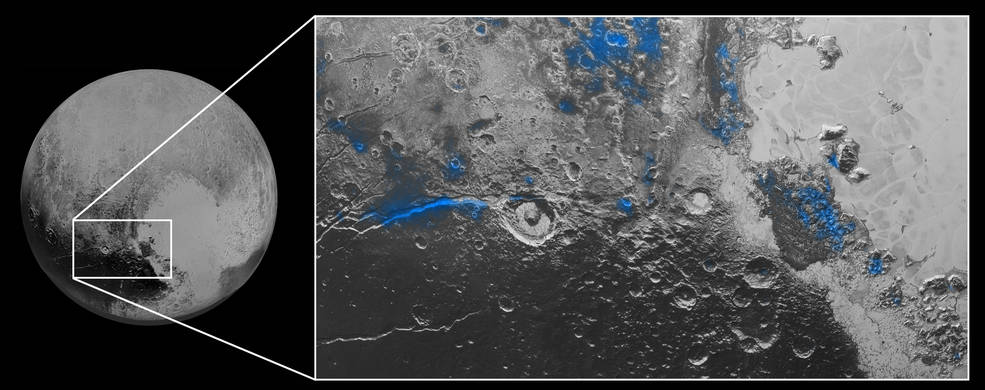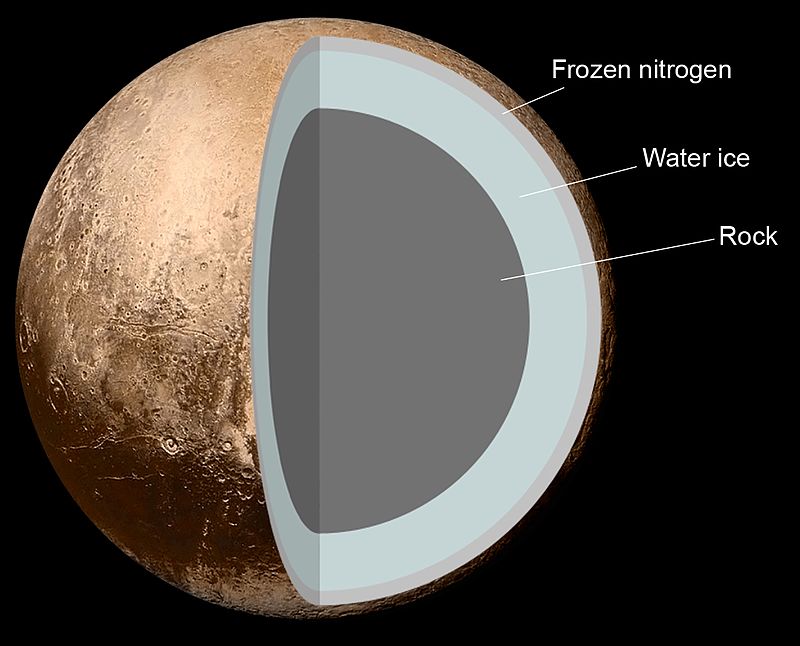Geology
Due to Pluto's distance from Earth, in-depth study from Earth is challenging. On , NASA's New Horizons space probe flew through the Pluto system, and the 50 gigabits (or 6.25 gigabytes) of information it gathered was transmitted to Earth. The final data transmission was , at 05:48 pm ET.
Surface
The plains on Pluto's surface are composed of more than 98 percent nitrogen ice, with traces of methane and carbon monoxide. Nitrogen and carbon monoxide are most abundant on the anti-Charon face of Pluto (around 180° longitude, where Tombaugh Regio's western lobe, Sputnik Planitia, is located), whereas methane is most abundant near 300° east. The mountains are made of water ice. Pluto's surface is quite varied, with large differences in both brightness and color. Pluto is one of the most contrastive bodies in the Solar System, with as much contrast as Saturn's moon Iapetus. The color varies between charcoal black, dark orange and white. Pluto's color is more similar to that of Io with slightly more orange, significantly less red than Mars. Notable geographical features include Tombaugh Regio, or the "Heart" (a large bright area on the side opposite Charon), Cthulhu Regio, or the "Whale" (a large dark area on the trailing hemisphere), and the "Brass Knuckles" (a series of equatorial dark areas on the leading hemisphere).

Distribution of over 1000 craters of all ages on Pluto. The variation in density (with none found in Sputnik Planitia) indicates a long history of varying geological activity.

Geologic map of Sputnik Planitia, with convection cell margins outlined in black.

Sputnik Planitia is covered with churning nitrogen ice "cells" that are geologically young and turning over due to convection.
Sputnik Planitia, the western lobe of the "Heart", is a 1000 km-wide basin of frozen nitrogen and carbon monoxide ices, divided into polygonal cells which are interpreted as convection cells that carry floating blocks of water ice crust and sublimation pits towards their margins; there are obvious signs of glacial flows both into and out of the basin. It has no craters that were visible to New Horizons, indicating that its surface is less than 10 million years old. The New Horizons science team summarized initial findings as "Pluto displays a surprisingly wide variety of geological landforms, including those resulting from glaciological and surface–atmosphere interactions as well as impact, tectonic, possible cryovolcanic, and mass-wasting processes.
Internal Structure
Pluto's density is 1.860±0.013 g/cm3. Because the decay of radioactive elements would eventually heat the ices enough for the rock to separate from them, scientists expect that Pluto's internal structure is differentiated, with the rocky material having settled into a dense core surrounded by a mantle of water ice. The diameter of the core is hypothesized to be approximately 1700 km, 70% of Pluto's diameter.
It is possible that such heating continues today, creating a subsurface ocean of liquid water some 100 to 180 km thick at the core–mantle boundary.In September 2016, scientists at Brown University simulated the impact believed to have formed Sputnik Planitia, and showed that it may have been the result of liquid water upwelling from below after the collision, implying the existence of a subsurface ocean at least 100 km deep.
Pluto has no magnetic field.
Mass and Size
Pluto's diameter is 2374±8 km and its mass is (1.303±0.003)×1022 kg, 17.7% that of the Moon (0.22% that of Earth). Its surface area is 1.665×107 km2, or roughly the same surface area as Russia. Its surface gravity is 0.063 g (compared to 1 g for Earth).
The discovery of Pluto's satellite Charon in enabled a determination of the mass of the Pluto–Charon system by application of Newton's formulation of Kepler's third law. Observations of Pluto in occultation with Charon allowed scientists to establish Pluto's diameter more accurately, whereas the invention of adaptive optics allowed them to determine its shape more accurately.
With less than 0.2 lunar masses, Pluto is much less massive than the terrestrial planets, and also less massive than seven moons: Ganymede, Titan, Callisto, Io, the Moon, Europa, and Triton. The mass is much less than thought before Charon was discovered.
Pluto is more than twice the diameter and a dozen times the mass of the dwarf planet Ceres, the largest object in the asteroid belt. It is less massive than the dwarf planet Eris, a trans-Neptunian object discovered in , though Pluto has a larger diameter of 2374 km compared to Eris's approximate diameter of 2326 km.
Determinations of Pluto's size had been complicated by its atmosphere, and hydrocarbon haze. In , Lellouch, de Bergh et al. published findings regarding methane mixing ratios in Pluto's atmosphere consistent with a Plutonian diameter greater than 2360 km, with a "best guess" of 2368 km. On , images from NASA's New Horizons mission Long Range Reconnaissance Imager (LORRI), along with data from the other instruments, determined Pluto's diameter to be 2,370 km (1,470 mi), which was later revised to be 2,372 km (1,474 mi) on July 24, and later to 2374±8 km.


